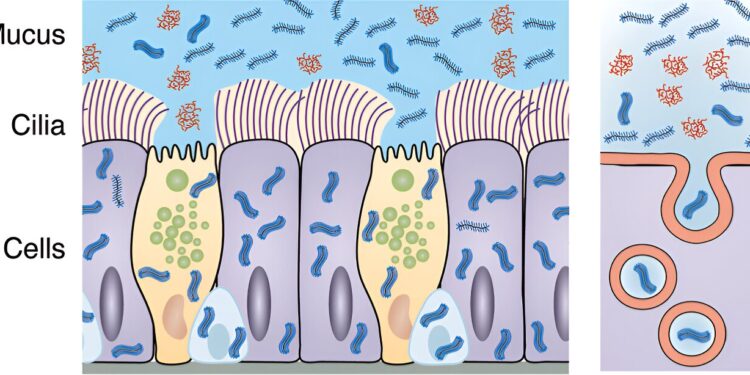This diagram shows that PEG-BB molecules, these bottlebrush-shaped objects, move through and beyond the mucus and periciliary layers to be internalized by cells throughout the epithelial layer. Credit: ACS Nano (2024). DOI: 10.1021/acsnano.4c01983
A drug-carrying molecule designed to cure diseases by bypassing the lungs’ natural defenses offers new hope for people with chronic or life-threatening respiratory diseases, say its creators, researchers in Assistant Professor Liheng Cai’s Soft Biomatter Lab in the University of Virginia’s School of Engineering and Applied Science.
Cai and his team, including Baiqiang Huang, a doctoral student in materials science and engineering, and Zhi-Jian He, a doctoral student in biomedical engineering, successfully demonstrated the nanocarrier’s effectiveness using the lab’s “micro-human airways.” The device captures the geometric and biological characteristics of human airways.
They describe their findings in an article published in the journal ACS Nano.
Sneaking past our defenses
Our lungs have protective layers that trap and transport pathogens or inhaled particles out of the respiratory system to prevent us from getting sick. Every time you blow your nose, the system is working.
“Unfortunately, these same barriers also prevent drugs from reaching targeted cells, making it difficult to treat diseases such as asthma, chronic obstructive pulmonary disease and pulmonary fibrosis,” Huang said.
The new polymer is called polyethylene glycol-based bottlebrush, or PEG-BB. It moves quickly through the walls of the airways by mimicking mucins, a natural glycoprotein responsible for the properties of mucus, which has the same shape as the bottlebrush: a central spine with a thick cluster of hairs extending outward.
“We reasoned that the flexibility and worm-like geometry of the brush carrier would allow it to slip through the tight mesh of mucus and gels surrounding the cilia to be internalized by epithelial cells, where drugs are needed to work,” Huang said.
Cilia are hair-like structures located on the surface of cells. They move in conjunction with mucus to repel and expel foreign matter.
To test their hypothesis, the team cultured human airway epithelial cells in their device. They introduced fluorescent PEG-BB molecules into the cells from two directions.
They then used a dye to penetrate the mucus and the periciliary layers, the latter being the gel surrounding the cilia. They did not stain the epithelial cell walls, which allowed the boundaries of the epithelium to be marked.
Using a specialized microscope and a dark room to sharpen the images, they were able to see how well the bright, bottlebrush-shaped molecules had moved through the cells.
A series of recent successes
“The human micro-airway is actually an equivalent place for cell growth,” Huang said.
“Its biological similarities allow us to study human lung defense, without harming living things,” added Cai, whose lab specializes in developing novel bottlebrush-shaped polymers for a range of uses, many of which push the boundaries of precision medicine.
For example, its bioprinting program recently produced what could be the first 3D building block for on-demand organ printing.
The PEG-BB results represent another success in the lab’s string of successes.
“We believe this innovation not only promises better treatments for lung diseases with reduced side effects, but also opens up possibilities for treating conditions affecting mucosal surfaces throughout the body,” Cai said.
The lab’s next step is to test PEG-BB’s ability to transport drug molecules across a mucosal barrier. The team is experimenting with in vitro and in vivo models on mice.
More information:
Zhi-Jian He et al., Polyethylene glycol Bottlebrush nanocarriers move across human airway epithelium via molecular architecture-enhanced endocytosis, ACS Nano (2024). DOI: 10.1021/acsnano.4c01983
Provided by the University of Virginia
Quote: Engineers design similar drug nanocarrier to evade lung defense lines (2024, August 22) retrieved August 22, 2024, from
This document is subject to copyright. Apart from any fair dealing for the purpose of private study or research, no part may be reproduced without written permission. The content is provided for informational purposes only.



